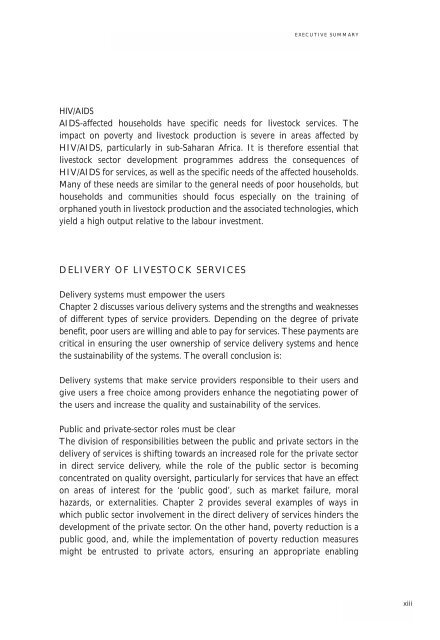Livestock Services and the Poor: A global initiative - IFAD
Livestock Services and the Poor: A global initiative - IFAD
Livestock Services and the Poor: A global initiative - IFAD
You also want an ePaper? Increase the reach of your titles
YUMPU automatically turns print PDFs into web optimized ePapers that Google loves.
E XECUTIVE SUMMARY<br />
HIV/AIDS<br />
AIDS-affected households have specific needs for livestock services. The<br />
impact on poverty <strong>and</strong> livestock production is severe in areas affected by<br />
HIV/AIDS, particularly in sub-Saharan Africa. It is <strong>the</strong>refore essential that<br />
livestock sector development programmes address <strong>the</strong> consequences of<br />
HIV/AIDS for services, as well as <strong>the</strong> specific needs of <strong>the</strong> affected households.<br />
Many of <strong>the</strong>se needs are similar to <strong>the</strong> general needs of poor households, but<br />
households <strong>and</strong> communities should focus especially on <strong>the</strong> training of<br />
orphaned youth in livestock production <strong>and</strong> <strong>the</strong> associated technologies, which<br />
yield a high output relative to <strong>the</strong> labour investment.<br />
Delivery of <strong>Livestock</strong> <strong>Services</strong><br />
Delivery systems must empower <strong>the</strong> users<br />
Chapter 2 discusses various delivery systems <strong>and</strong> <strong>the</strong> strengths <strong>and</strong> weaknesses<br />
of different types of service providers. Depending on <strong>the</strong> degree of private<br />
benefit, poor users are willing <strong>and</strong> able to pay for services. These payments are<br />
critical in ensuring <strong>the</strong> user ownership of service delivery systems <strong>and</strong> hence<br />
<strong>the</strong> sustainability of <strong>the</strong> systems. The overall conclusion is:<br />
Delivery systems that make service providers responsible to <strong>the</strong>ir users <strong>and</strong><br />
give users a free choice among providers enhance <strong>the</strong> negotiating power of<br />
<strong>the</strong> users <strong>and</strong> increase <strong>the</strong> quality <strong>and</strong> sustainability of <strong>the</strong> services.<br />
Public <strong>and</strong> private-sector roles must be clear<br />
The division of responsibilities between <strong>the</strong> public <strong>and</strong> private sectors in <strong>the</strong><br />
delivery of services is shifting towards an increased role for <strong>the</strong> private sector<br />
in direct service delivery, while <strong>the</strong> role of <strong>the</strong> public sector is becoming<br />
concentrated on quality oversight, particularly for services that have an effect<br />
on areas of interest for <strong>the</strong> ‘public good’, such as market failure, moral<br />
hazards, or externalities. Chapter 2 provides several examples of ways in<br />
which public sector involvement in <strong>the</strong> direct delivery of services hinders <strong>the</strong><br />
development of <strong>the</strong> private sector. On <strong>the</strong> o<strong>the</strong>r h<strong>and</strong>, poverty reduction is a<br />
public good, <strong>and</strong>, while <strong>the</strong> implementation of poverty reduction measures<br />
might be entrusted to private actors, ensuring an appropriate enabling<br />
xiii

















